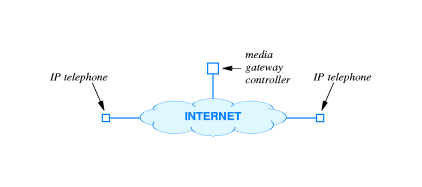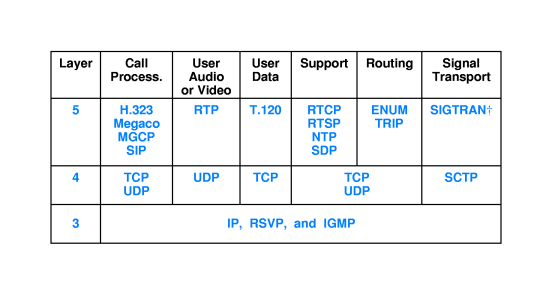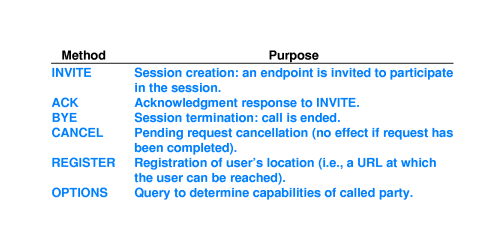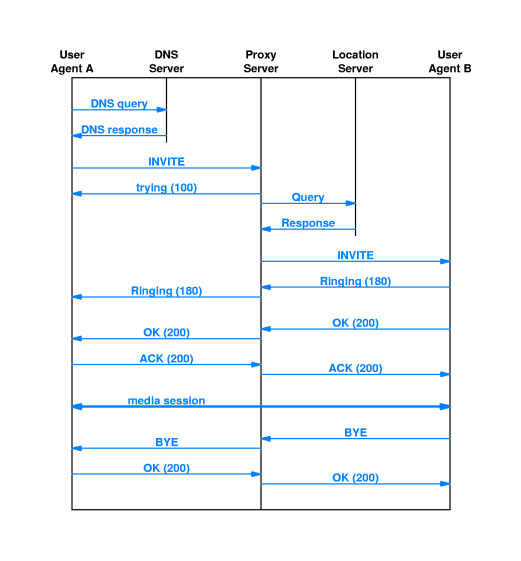(Latest Revision:
Sun Apr 29 15:00 2007
)
Notes On Chapter Thirty-Three
-- IP Telephony (VoIP)
33.1 Introduction
- This chapter is about VoIP concepts,
terminology and protocols.
33.2 The Motivation and Challenge of IP Telephony
- Expectations are it will be cost-effective
to use the Internet for both data and voice communication.
- The basic idea:
- continuously sample audio
- convert to digital
- transmit across the Internet
- convert back to analog for playback
- Details & Complications:
- can't wait to fill large packets ... transmission delay
- IP address <--> Telephone number translation
- call-acceptance protocol
- call-termination protocol
- bridging between Internet and the traditional
Public Switched Telephone Network (PSTN)
- call forwarding
- call waiting
- voicemail
- conference calls
- caller ID
- PBX services
33.3 Encoding, Transmission, and Playback
- Both the International Telecommunications Union (ITU) and the
Internet Engineering Task Force (IETF) have created standards for IP
telephony. Both ITU and IETF IP telephony
standards agree on these points:
- use Pulse Code Modulation (PCM)
for encoding audio,
- transfer digitized audio using the
Real-Time Transport Protocol (RTP), and
- encapsulate each RTP message in a UDP
datagram
- TCP is not suitable for real-time voice transmission. It does no
good to retransmit lost or late packets. RTP
uses UDP and tolerates momentary silence when packets don't
arrive in time for playback.
- Each RTP message carries a sequence number and real-time clock
value. Receivers use sequence numbers and
real-time clock values to sequence playback correctly.
33.4 Signaling Systems and Protocols
- Signaling consists of the
processes of establishing and terminating a
call.
- There are proponents of both centralized signaling and
distributed signaling for IP telephony.
- Proponents of the centralized approach
say it would help with providing service
guarantees.
- Proponents of the distributed approach
feel it will be easier to implement and scale
up.
- Whatever signaling system is employed, it has
to be compatible with Signaling System 7 (SS7), which
is used by the traditional phone service.
- Existing proposed IP signaling protocols:
- IETF's Session Initiation Protocol (SIP)
- ITU's H.323
- Megaco and Media Gateway Control Protocol (MGCP)
33.5 Basic IP Telephone System
- An IP telephone can be a computer
equipped with audio hardware and special software, or it can be a
separate specialized hardware unit.
- Besides IP telephones, an IP telephony system
requires a Media Gateway Controller to allow
telephones to "find each other."

33.6 Inter-Operation with Other Telephone Systems
- An IP telephone system needs:
- a Media Gateway, and
- a Signaling Gateway
in order to interoperate with the Public Switched Telephone Network
(PSTN) or another IP telephone system.
- A Media Gateway provides translation between
different audio formats.
- A Signaling Gateway translates between
different signaling protocols.
- A Media Gateway Controller coordinates media
and signaling gateways.
(See figure 33.2 below.)

33.7 Alternative Terminology and Concepts
- 33.7.1 Session Initiation Protocol (SIP) Terminology and Concepts
- A user agent makes or terminates phone calls.
- A location server manages database of info about each
user & is contacted during call setup.
- A proxy server forwards requests, handles routing, &
enforces policy.
- A redirect server handles call forwarding & 800-number
connections.
- A registrar server updates the location database & authenticates
registration requests.
- 33.7.2 H.323 Terminology and Concepts
- A terminal functions as IP telephone & perhaps can
transmit data and/or video
- A gatekeeper performs location and signaling &
coordinates operation of gateway.
- The gateway connects IP telephone system with the Public
Switched Telephone Network (PSTN)
- A multipoint control unit (MCU) provides such services
as multipoint conferencing.
- 33.7.3 ISC Terminology and Concepts
- The International Softswitch Consortium (ISC) presents a
unifying model and defines a list of functions that suffice
for all situations:
- Media Gateway Controller Function (MGC-F)
- Call Agent Function (CA-F)
- InterWorking Function (IW-F)
- Routing Function and Accounting Function (R-F/A-F)
- Signaling Gateway Function (SG-F)
- Access Gateway Signaling Function (AGS-F)
- Application Server Function (AS-F)
- Service Control Function (SC-F)
- Media Gateway Function (MG-F)
- Media Server Function (MS-F)
33.8 Proposed Protocols and Layering
- The figure below depicts proposed protocols and their positions in
the 5-layer Internet Reference Model.

33.9 H.323 Characteristics
33.10 H.323 Layering
- H.323 can use both TCP and UDP over IP. For example audio over UDP
and data over TCP.

33.11 SIP Characteristics and User Identification
33.12 SIP Methods

33.13 An Example SIP Session

33.14 Telephone Number Mapping and Routing
- E.164
- E.164 NUMbers (ENUM)
- Uniform Resource Locator (URI)
- e164.arpa
- Telephone Routing over IP (TRIP)
- IP Telephone Administrative Domains (ITAD's)
33.15 IP Telephones and Electrical Power
- IEEE standard 802.3af provides low-voltage power over the wires used
for ethernet.
33.16 Summary





